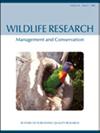高质量的栖息地和旅游业的避难所减少了森林专家的个体应激反应
IF 1.6
3区 生物学
Q3 ECOLOGY
引用次数: 0
摘要
本文章由计算机程序翻译,如有差异,请以英文原文为准。
High-quality habitats and refuges from tourism reduce individual stress responses in a forest specialist
ABSTRACT Context. The assessment of suitable habitat for a species is often evaluated based merely on where the species is most abundant. However, a variety of environmental factors such as temperature, resources and human disturbances might force animals to avoid otherwise high-quality habitats. Additionally, individuals’ capacities to cope with such factors – as reflected in physiological stress responses – may also contribute to avoidance. Combining measures of stress response of individual animals with habitat suitability models may contribute essential insights to the development of species conservation plans. Aims. We used a landscape-level approach to assess whether habitat quality, abiotic factors and human disturbance affect the physiological stress response of a forest specialist, the capercaillie (Tetrao urogallus), and to what extent these relationships are determined by variation between individuals. Methods. We applied a non-invasive approach by collecting 1096 droppings across the entire species range in two adjacent national parks spanning the border between the Czech Republic and Germany. We measured faecal corticosterone metabolites (FCMs) to evaluate the physiological stress response. To test the influences of temperature, habitat quality, season and sex, as well as forest management and tourism intensity on FCM levels, we used generalised additive mixed effect models (GAMMs). The same models were applied for a reduced subset of randomly selected samples that were attributed to individuals via DNA profiling using 10 microsatellite loci. This approach allowed us to control for possible individual differences (through repeated measures within individual genotypes). Key results. Both models revealed decreasing FCM levels with increasing habitat quality and showed no relationship between increasing forestry intensity and FCMs. When accounting for individual identity, we found a significant positive effect from increasing tourism intensity, although this relationship was not significant in the full dataset. Conclusions. Our results highlight three conclusions for the conservation of capercaillie: (1) high-quality habitats reduce stress levels; (2) tourism-free refuge areas are important, and (3) individuality appears to be a strong determinant of response to environmental factors. Implications. Generalising management recommendations from observations for single individuals to an entire population may be inappropriate.
求助全文
通过发布文献求助,成功后即可免费获取论文全文。
去求助
来源期刊

Wildlife Research
生物-动物学
CiteScore
4.30
自引率
15.80%
发文量
56
审稿时长
3 months
期刊介绍:
Wildlife Research represents an international forum for the publication of research and debate on the ecology, management and conservation of wild animals in natural and modified habitats. The journal combines basic research in wildlife ecology with advances in science-based management practice. Subject areas include: applied ecology; conservation biology; ecosystem management; management of over-abundant, pest and invasive species; global change and wildlife management; diseases and their impacts on wildlife populations; human dimensions of management and conservation; assessing management outcomes; and the implications of wildlife research for policy development. Readers can expect a range of papers covering well-structured field studies, manipulative experiments, and analytical and modelling studies. All articles aim to improve the practice of wildlife management and contribute conceptual advances to our knowledge and understanding of wildlife ecology.
Wildlife Research is a vital resource for wildlife scientists, students and managers, applied ecologists, conservation biologists, environmental consultants and NGOs and government policy advisors.
Wildlife Research is published with the endorsement of the Commonwealth Scientific and Industrial Research Organisation (CSIRO) and the Australian Academy of Science.
 求助内容:
求助内容: 应助结果提醒方式:
应助结果提醒方式:


